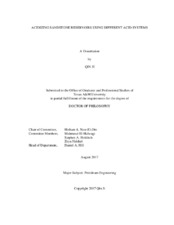| dc.description.abstract | AlCl₃ has been long used as a retarding agent for mud acid, its applications studied in the lab and tested in the field. The theory and mechanism of AlCl₃ retardation have been investigated in many projects involving mud acidizing and reservoir permeability enhancement. This dissertation advances this investigation by using solubility tests, coreflood tests, and ¹⁹F Nuclear Magnetic Resonance (NMR) to better understand the mechanism of AlCl₃ working as a retarding agent in mud acid. To enhance the acid performance and to minimize formation damage, this study provides a systematic investigation of the interactions between the Al-based retarded mud acid and clay minerals in sandstone reservoirs. Furthermore, for the first time, ¹⁹F NMR spectroscopy was used to follow the reactions of Al-based retarded mud acid with clay minerals.
Solubility tests were performed to evaluate the retardation of the Al-based retarded mud acid when reacted with kaolinite, bentonite, and illite. Inductively Coupled Plasma (ICP) and ¹⁹F NMR were used to analyze the concentrations of key cations and components in the supernatant while the Scanning Electron Microscopy (SEM) and Energy Dispersive X-ray Spectroscopy (EDS) techniques were used to identify the reaction products and detect any precipitation.
This study shows that AlCl₃ can retard the reaction of HF with kaolinite, bentonite, or illite at 75 and 200°F in Al-based retarded mud acid. Even with 5 wt% AlC₃∙6H₂O added to the acid system, no AlF₃ precipitate was observed in any of the solubility tests. Coreflood tests showed significant permeability improvement in the Berea sandstone when Al-based retarded mud acid was used. The enhancement diminished when the temperature increased to 300°F. CT scan showed deeper penetration of Al-based retarded mud acid than mud acid at 75°F, and the penetration reduced when temperature increased to 200°F. Based on these results, new mechanisms were developed to better understand the reaction of Al-based retarded mud acid and clay minerals.
Field tests were followed in this study. The optimal acidizing plan was found for the Katz field after a series of coreflood experiments. This study provides the guidelines for designing the acidizing jobs in the Katz field. | en |


